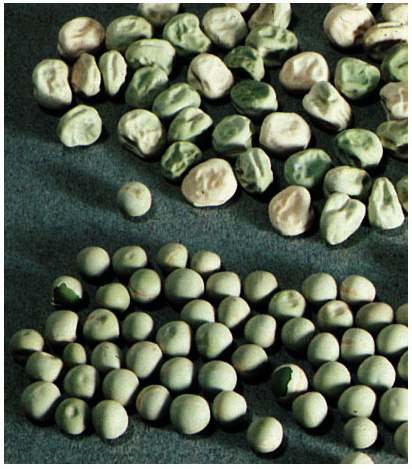Why Wrinkled Peas Are WrinkledWrinkled peas were one variety used by Mendel in his experiments, but he had no idea how peas became wrinkled or round (smooth). All Mendel needed to know was that a “factor” controls seed shape and that it has two forms—a dominant one for round (smooth) shape and a recessive one for wrinkled shape.
Recently, scientists have discovered how peas become wrinkled, providing a connection between a gene and its phenotype. While the pea is developing, starch is synthesized and stored as a food source. Starch is a large, branched molecule made up of sugar (glucose) molecules, and the ability to form branches is controlled by the SBEI (starch branching enzyme I) gene. Normally, starch molecules are highly branched structures. This allows more sugar to be stored in each molecule. In wrinkled peas, the branching gene is inactive, so the developing pea converts sugar into starch very slowly and excess sugar accumulates. The excess sugar causes the pea to take up large amounts of water through osmosis, causing the seed to swell. In a final stage of development, the seeds lose volume as they dry out. In homozygous wrinkled peas (rr), more water is lost than in the round seeds (RR or Rr), causing the outer shell of the pea to become wrinkled.
Mendel’s contribution was to show that a specific factor controlled a trait and that a given gene could have different forms. Now we know that genes exert their effect on phenotype through the production of a gene product (protein).
